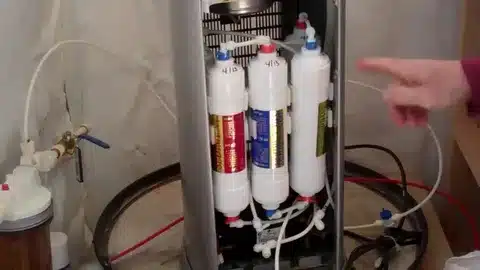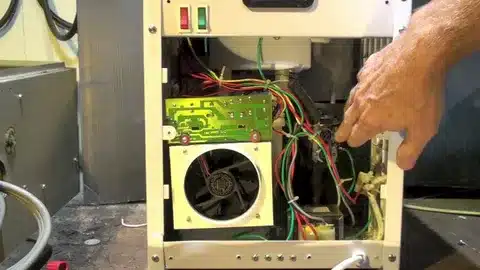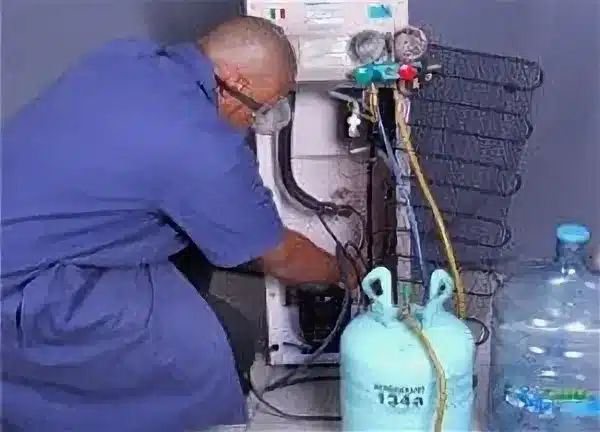Introduction Water Dispenser Repair
Water Dispenser Repair wqin the scorching heat of summer or during a busy workday, a water dispenser can be your best friend, providing you with easy access to refreshing water. However, like any appliance, water dispensers can occasionally encounter issues that disrupt their functionality. In this comprehensive guide, we will explore common problems associated with water dispensers and provide step-by-step solutions to keep your thirst quenched. Whether you have a traditional bottled water cooler or a modern point-of-use dispenser, this article has got you covered. Water Dispenser Repair near me

Table of Contents
- Understanding the Types of Water Dispensers
- 1.1. Bottled Water Dispensers
- 1.2. Point-of-Use Water Dispensers
- Common Water Dispenser Issues
- 2.1. Leaking Water
- 2.2. No Cold Water
- 2.3. No Hot Water
- 2.4. Strange Tastes or Odors
- 2.5. Dispenser Not Working at All
- Diagnosing the Problem
- 3.1. Checking the Power Source
- 3.2. Inspecting the Water Bottle
- 3.3. Examining the Water Supply
- 3.4. Evaluating the Filters
- DIY Water Dispenser Repair
- 4.1. Fixing Leaks
- 4.2. Restoring Cold Water
- 4.3. Restoring Hot Water
- 4.4. Eliminating Strange Tastes or Odors
- 4.5. Troubleshooting Total Breakdowns
- When to Call a Professional
- 5.1. Complex Electrical Issues
- 5.2. Complicated Plumbing Problems
- 5.3. Refrigeration System Failures
- Maintenance Tips to Prevent Future Issues
- 6.1. Regular Cleaning
- 6.2. Changing Filters
- 6.3. Inspecting Electrical Components
- Ensuring Hygiene
- 7.1. Cleaning the Drip Tray
- 7.2. Sanitizing the Water Reservoir
- 7.3. Cleaning the Faucets
- Conclusion
- 8.1. Keeping Your Water Dispenser Running Smoothly

Understanding the Types of Water Dispensers
Before delving into water dispenser repair, it’s crucial to understand the two primary types of water dispensers available in the market.
1.1. Bottled Water Dispensers
Water Dispenser Repair near me Bottled water dispensers use large plastic or glass bottles that are placed on top of the unit. These bottles contain water that is dispensed through the unit’s taps. They are commonly found in homes and offices, offering the convenience of hot and cold water at the push of a button.
1.2. Point-of-Use Water Dispensers
Water Dispenser Repair near me Point-of-use water dispensers are directly connected to a water source, such as your home’s plumbing. These dispensers eliminate the need for bottled water and provide a continuous supply of hot and cold water. They are more environmentally friendly and cost-effective in the long run.
Common Water Dispenser Issues
Now that we have a clear understanding of the types of water dispensers let’s dive into the common problems you might encounter.
2.1. Leaking Water
Water Dispenser Repair near me One of the most frustrating issues with water dispensers is water leakage. It can occur for various reasons, including damaged seals, loose connections, or a malfunctioning valve.
To address this issue, follow these steps:
- Turn Off the Dispenser: Unplug the dispenser or turn it off at the power source.
- Inspect for Damage: Carefully examine all components for visible damage.
- Tighten Connections: Ensure all connections are secure.
- Replace Faulty Parts: If you identify damaged components, replace them.
- Test the Dispenser: Turn it back on and check for leaks.
If the problem persists, consider seeking professional help.

2.2. No Cold Water
Water Dispenser Repair near me When your dispenser fails to provide cold water, it can be a major inconvenience. This issue is often related to problems with the refrigeration system.
To troubleshoot this problem:
- Check the Temperature Settings: Ensure the thermostat is set to a cold temperature.
- Inspect the Compressor: Listen for any unusual sounds coming from the compressor.
- Clean the Condenser Coils: Dust and debris can affect cooling efficiency.
- Professional Assistance: If the issue persists, consult a technician to inspect the refrigeration system.
2.3. No Hot Water
Similarly, if your dispenser isn’t dispensing hot water as it should, it may be due to issues with the heating element or thermostat.
To address this problem:
- Check the Thermostat: Make sure it’s set to the desired hot water temperature.
- Inspect the Heating Element: Look for signs of damage or malfunction.
- Professional Help: If the problem persists, consult a professional to examine and repair the heating system. Water Dispenser Repair near me
2.4. Strange Tastes or Odors
If your water dispenser is producing water with strange tastes or odors, it’s likely related to the water source or filters.
To resolve this issue:
- Change the Filters: Replace the filters in your dispenser.
- Flush the System: Run several gallons of water through the system to clear any lingering odors.
- Check Water Source: Ensure the water source is clean and free from contaminants.
2.5. Dispenser Not Working at All
In the worst-case scenario, your water dispenser might stop working entirely. Before panicking, let’s explore some solutions.
To troubleshoot:
- Check the Power: Ensure the dispenser is plugged in and receiving power.
- Inspect Circuit Breakers: Verify that circuit breakers or fuses haven’t tripped.
- Seek Professional Help: If the dispenser remains non-functional, consult a technician to diagnose and repair electrical issues. Water Dispenser Repair near me
Diagnosing the Problem
Now that we’ve identified common issues, let’s delve into how to diagnose the problem effectively.
3.1. Checking the Power Source
Start by confirming that your dispenser is properly connected to a power source. If it’s unplugged or the outlet isn’t working, your dispenser won’t function. Water Dispenser Repair near me
3.2. Inspecting the Water Bottle
For bottled water dispensers, inspect the water bottle for any damage, leaks, or issues with the cap. A damaged bottle can lead to water leakage or contamination.
3.3. Examining the Water Supply
If you have a point-of-use dispenser, check the water supply. Ensure that the water inlet valve is open and that there are no obstructions in the water line.
3.4. Evaluating the Filters
Examine the filters for signs of clogging or damage. Filters play a crucial role in maintaining water quality, so replacing them regularly is essential.
DIY Water Dispenser Repair
Now, let’s move on to DIY solutions for common water dispenser problems.
4.1. Fixing Leaks
If you’ve identified a leak, follow these steps:
- Turn Off the Dispenser: Ensure it’s unplugged or powered off.
- Locate the Leak: Identify the source of the leak.
- Tighten Connections: If it’s a loose connection, tighten it. If it’s a damaged part, replace it.
- Test the Dispenser: Turn it back on and monitor for leaks.
4.2. Restoring Cold Water
To restore cold water:
- Check the Thermostat: Set it to a lower temperature if needed.
- Clean the Condenser Coils: Remove dust and debris to improve cooling.
- Inspect Compressor: If it’s making unusual noises, consider professional help.
4.3. Restoring Hot Water
To bring back hot water:
- Adjust the Thermostat: Ensure it’s set to the desired hot water temperature.
- Examine the Heating Element: Replace if damaged.
- Professional Assistance: If the issue persists, consult a technician for heating system repair.
4.4. Eliminating Strange Tastes or Odors
To tackle odd tastes or odors:
- Change the Filters: Install new filters.
- Flush the System: Run several gallons of water to clear any lingering tastes or odors.
- Check Water Source: Ensure the source water is clean.
4.5. Troubleshooting Total Breakdowns
If your dispenser is entirely non-functional:
- Verify Power Supply: Ensure it’s plugged in and the circuit breakers aren’t tripped.
- Consult a Professional: For electrical issues, call a technician for diagnosis and repair.
When to Call a Professional
While DIY solutions can resolve many issues, some problems require professional expertise.
5.1. Complex Electrical Issues
If you suspect complex electrical problems, such as issues with the control board or wiring, it’s best to consult a technician.
5.2. Complicated Plumbing Problems
Issues related to water inlet valves, internal plumbing, or water lines should be handled by professionals with plumbing expertise.
5.3. Refrigeration System Failures
When the refrigeration system is involved, such as a malfunctioning compressor, professional repair is essential.
Maintenance Tips to Prevent Future Issues
Prevention is key to avoiding water dispenser problems in the future. Here are some maintenance tips:
6.1. Regular Cleaning
Clean the drip tray, faucets, and reservoir regularly to prevent mold and bacteria growth.
6.2. Changing Filters
Replace filters as recommended by the manufacturer to maintain water quality.
6.3. Inspecting Electrical Components
Periodically check wiring and electrical components for signs of wear or damage.
Ensuring Hygiene
Maintaining hygiene in your water dispenser is crucial for your health.
7.1. Cleaning the Drip Tray
Clean the drip tray weekly to prevent mold and bacteria buildup.
7.2. Sanitizing the Water Reservoir
Sanitize the water reservoir every few months to ensure clean water.
7.3. Cleaning the Faucets
Regularly clean the faucets to prevent contamination.

Conclusion
Water Dispenser Repair near me In conclusion, a water dispenser is a valuable appliance that can provide you with clean and refreshing water. By understanding common problems and performing basic maintenance, you can keep your dispenser running smoothly for years to come.
Water Dispenser Repair near me Remember that while some issues can be resolved with DIY solutions, it’s essential to know when to seek professional help for complex problems.
Now, go ahead and enjoy the convenience of your well-maintained water dispenser!
FAQs (Frequently Asked Questions)
Q1: How often should I clean my water dispenser?
Regular cleaning is essential. Clean the drip tray and sanitize the water reservoir at least once a month for optimal hygiene.
Q2: Can I use vinegar to clean my water dispenser?
Yes, you can use a vinegar solution to clean the water reservoir and remove mineral deposits. Be sure to rinse thoroughly afterward.
Q3: Why does my water taste strange even after changing the filter?
Water Dispenser Repair near me Strange-tasting water can be caused by the water source. Ensure your tap water is of good quality, and consider using a water filter pitcher for additional purification.
Q4: How can I prevent algae growth in my water dispenser?
To prevent algae growth, keep your dispenser away from direct sunlight and regularly clean and sanitize the reservoir.
Q5: Is it safe to repair the electrical components of my water dispenser myself?
It’s not recommended unless you have experience with electrical repairs. Electrical issues can be hazardous, so it’s best to consult a professional technician.Water Dispenser Repair near me
